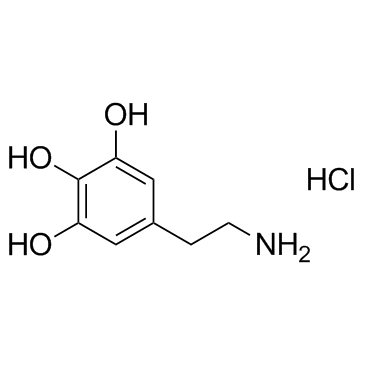5-Hydroxydopamine hydrochloride

5-Hydroxydopamine hydrochloride structure
|
Common Name | 5-Hydroxydopamine hydrochloride | ||
|---|---|---|---|---|
| CAS Number | 5720-26-3 | Molecular Weight | 205.63900 | |
| Density | 1.395 g/cm3 | Boiling Point | 414.5ºC at 760 mmHg | |
| Molecular Formula | C8H12ClNO3 | Melting Point | 218-220ºC(lit.) | |
| MSDS | Chinese USA | Flash Point | 204.5ºC | |
| Symbol |

GHS07 |
Signal Word | Warning | |
|
A microdialysis study on striatal dopamine, 5-HT and metabolites in conscious rats after various treatments: evidence for extravesicular release of dopamine.
Neuroreport 5(1) , 53-6, (1993) The effects of death and various treatments that affect the status of nigrostriatal neurones on striatal release of dopamine (DA) and 5-hydroxytryptamine (5-HT) and their metabolites 3,4-dihydroxyphenylacetic acid (DOPAC), 3-methoxy-4-hydroxyphenylethylamine ... |
|
|
Biochemical and behavioral recovery in a rodent model of Parkinson's disease following stereotactic implantation of dopamine-containing liposomes.
Exp. Neurol. 115(2) , 193-9, (1992) We have developed and characterized dopamine-containing liposomes which exhibited in vitro sustained release of dopamine for over 40 days. These liposomes were stereotactically implanted into the partially denervated corpus striatum of rats subjected to unila... |
|
|
Uptake of 5-hydroxydopamine into non-sympathetic nerves of guinea-pig uterine artery in late pregnancy.
J. Neurocytol. 22(3) , 164-75, (1993) Perivascular nerve fibres of the uterine artery of virgin and late pregnant guinea-pigs were examined under the electron microscope following loading with 5-hydroxydopamine, a marker for catecholamine uptake, and immunohistochemistry for dopamine beta hydroxy... |
|
|
Protective effects of green tea polyphenols and their major component, (-)-epigallocatechin-3-gallate (EGCG), on 6-hydroxydopamine-induced apoptosis in PC12 cells.
Redox Rep. 7(3) , 171-7, (2002) Green tea polyphenols exert a wide range of biochemical and pharmacological effects, and have been shown to possess antimutagenic and anticarcinogenic properties. Oxidative stress is involved in the pathogenesis of Parkinson's disease. However, although green... |
|
|
Electron microscopic evidence for neurotoxicity in the basal ganglia.
Neurochem. Int. 26(2) , 195-202, (1995) The dopaminergic projection from the substantia nigra to the neostriatum is vulnerable to several neurotoxins including 1-methyl-4-phenyl-1,2,3,6-tetrahydropyridine (MPTP), amphetamine, and 5-hydroxydopamine. We have treated rats or mice with these agents and... |
|
|
Pyruvic acid cytoprotection against 1-methyl-4-phenylpyridinium, 6-hydroxydopamine and hydrogen peroxide toxicities in vitro.
Neurosci. Lett. 337(2) , 77-80, (2003) The neuropathology of Parkinson's disease (PD) involves a reduction of endogenous antioxidant enzyme systems, heightened oxidative stress and mitochondrial aberrations in the region of the substantia nigra. Similarly, neurotoxins commonly used to investigate ... |
|
|
Effects of 5-hydroxydopamine and 6-hydroxydopamine on the ultrastructure of type I cells in paraganglia of the rat recurrent laryngeal nerve.
Arch. Histol. Cytol. 55(1) , 57-65, (1992) The ultrastructure of the Type I cells in paraganglia of rat recurrent laryngeal nerve (RLN) was studied after the administration of 5-hydroxydopamine (5-OHDA) and 6-hydroxydopamine (6-OHDA). Normal Type I cells of RLN-paraganglia contained abundant organelle... |
|
|
The effects of 5-hydroxydopamine on salivary flow rates and protein secretion by the submandibular and parotid glands of rats.
Exp. Physiol. 81(4) , 645-53, (1996) The secretory effects of 5-hydroxydopamine (5-OHDA) were tested in Nembutal-anaesthetized adult male Sprague-Dawley rats injected I.V. over a wide range of doses, with and without various autonomic antagonists and Ca2+ channel blockers. Polyacrylamide disc ge... |
|
|
Differential dopaminergic regulation of proenkephalin and prodynorphin mRNAs in the basal ganglia of rats.
Brain Res. Mol. Brain Res. 12(1-3) , 259-66, (1992) Proenkephalin and prodynorphin mRNA levels in the caudate-putamen and in the nucleus accumbens of rats were measured by in situ hybridization 2, 4 and 8 weeks following unilateral lesion of the medial forebrain bundle by 6-hydroxydopamine (6-OHDA). After 2 we... |
|
|
Molecular cloning and characterization of rat karyopherin alpha 1 gene: structure and expression.
Gene 331 , 149-57, (2004) Dopamine denervation in the striata of patients with Parkinson's disease (PD) leads to changes in neural plasticity. However, the mechanisms leading to the changes are still poorly understood. In an effort to study the molecular events in the denervated stria... |